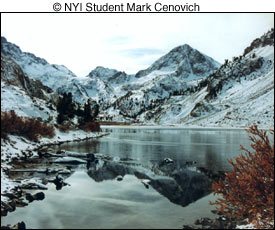
'Tis the season, and we're getting lots of letters from NYIP students and other Northern Hemisphere Web visitors about taking cold weather pictures, particularly since a good portion of the U.S. is currently under a deep freeze. There are lots of great photo opportunities out there whether your idea of a good time is ice fishing, snow shoeing or just plain walking in the winter wonderland. You just need to get out there and follow a few important winter photo tips.
The letters we get reveal that the proper steps for winter camera protection are often confused in people's minds. Here's an e-mail we got recently from a photographer in Ontario, Canada, that is typical: "I am happily snapping away, but having a bit of a problem keeping my camera warm and unfrozen in our cold, blustery weather. If I carry it bundled under my coat, should I keep it in a plastic bag (I read about this somewhere) to prevent condensation? Any other suggestions for camera protection?"
Okay. You asked. Here are the facts and the answers to all the basic camera tips regarding cold weather.
The problem with lots of camera tips about cold weather photography is that they get out of sequence. Here's why. There are really three different scenarios to consider: First, what to do when you take your camera from a warm, cozy home or car into the bitter cold outside. Second, what to do when you're shooting pictures outside in the cold. Third, what to do when you finally bring your freezing camera back into that warm cozy house or car.
First, what should you do when you bring your warm camera outside to take cold weather pictures? Do you have to worry about moisture condensing from the cold air onto the warm surface of the lens or the electronics? No. One of the handiest winter photo tips to know: Cold air has low moisture content. There's little or no condensation when you go outside into the cold. (As we'll discuss, this becomes a problem when you go back inside.)
So what's the problem? The main problem is loss of battery power!
Batteries
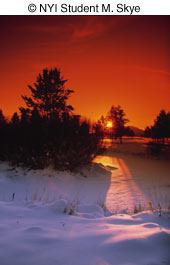
The chemistry and physics of how batteries generate electrical energy means that at very low temperatures all batteries lose power. They're just not as efficient. This is a particularly serious problem with today's digital cameras that are totally dependent on battery power. So, when you take your camera and flash out into the cold, you should anticipate a loss of battery power. How do you prepare for this?
First, by keeping the camera and flash (and their batteries) as warm as possible, even outdoors. To do this, when you go outdoors, carry them close to your body, for example, under your coat. Let them share your body warmth except for those brief moments when you are actually taking a picture. (Keeping your camera protected and warm this way will also minimize the possibility of a manual shutter sticking because its lubricant freezes.)
The second way you prepare for the expected loss of battery power when taking cold weather pictures is to bring spare batteries with you when you go outside. And keep these spares close to your body too; for example, in a shirt pocket where they will also benefit from your body heat. Then, if your camera (or flash) batteries start to fail, you can insert warm fresh batteries. Following these winter photo tips about batteries can save you a trip to the store and lost photo opportunities.
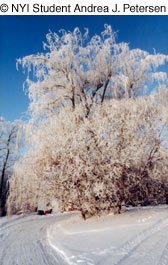
All right. You're outside now. What should you do differently because of the cold? Your objective is to continue to try to keep the camera and flash as warm as possible. For example, let's say you're staked out waiting for wildlife to appear over yonder hill. Set up your tripod, but if possible keep your camera protected under your coat until you're ready to shoot. Here's where a quick-release head comes in handy. When you see your quarry, pop the camera onto the tripod quickly and quietly. An ice-cold tripod will do its job for far longer than an ice-cold camera, which is likely to fail. Aluminum tripods, by the way, will eventually freeze when temperatures are well below zero, depending on the type of lubricant in the tripod's joints and head.
We've noticed that some digital cameras conk out quickly in cold weather. Carry lots of batteries. As we already noted, if you find your battery power failing, you have extra warm batteries with you.
Keep Yourself Warm
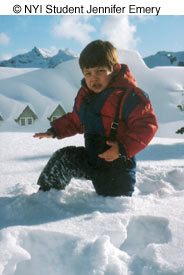
And the final camera tip for shooting cold weather photos is for you to keep warm. Dress in layers. Wear good warm boots. Bring along a Thermos of hot soup. (Coffee and alcohol are counterproductive; they make you less able to maintain your body warmth!) And, if it's really cold, consider some supplementary heating devices, such as skiers use – plastic packets of chemicals that can warm the hands or feet when they are kneaded, or even battery heated insoles for your boots. You need thick gloves, but these are not great when it comes to pressing the small buttons on your camera. So consider gloves sold in backpacking stores that have fingertips or mittens that can be folded back so that you can momentarily use your bare fingers.
Shooting in Snow
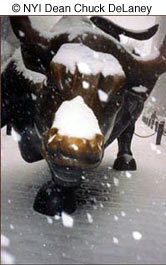
What about taking photographs when it's actually snowing or sleeting? If it's just a few flakes, simply keep your camera under your coat except when you shoot. Not long ago, we were outside photographing when a heavy snow squall hit. In a few seconds, the whole world was awash in swirling, blowing soggy snowflakes. This kind of heavy downfall can play havoc with the exposed parts of a DSLR, where any moisture can snarl the all-important circuits that control all the camera's functions.
Here's a camera tip for when it's really coming down. Don't use your DSLR for cold weather pictures during heavy snow unless you have it protected by a waterproof device such as the plastic-bag type housings made by Aquatech (aquatech.net). These handy gadgets are designed for snorkelers – you put your camera into the plastic bag and seal it. Your camera's lens is positioned so it "sees" though a clear optical glass filter. Your camera is protected from moisture by the plastic sack and the lens by the glass filter. We should note that these are fine for snowstorms as well as snorkeling. They aren't made for higher water pressure that scuba divers encounter at greater depths. That's another topic for another article.
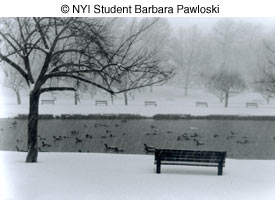
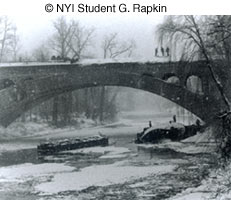
You'll also have to make sure that snowflakes or water droplets don't obscure the view of the lens. If necessary, wipe your lens with a dry, lint-free absorbent cloth. We use either a well-worn all-cotton t-shirt for this purpose, or a microfiber cleaning cloth.
If you follow these precautions, you should have no problem keeping your camera protected when working outdoors and taking advantage all the great opportunities for cold weather pictures that you encounter, regardless of the weather.
Condensation
Now it's time to come back indoors. Here's where you'll need a few winter photo tips about condensation because it can be a real problem. You've seen moisture condense on a cool glass of water on a hot summer day. Your lens and the electronics inside the camera behave the same way when you bring them inside – moisture from the warm inside air condenses on their cold surfaces. The lens can become completely covered with moisture, as can the mechanical and electrical components inside the camera. You don't want moisture – water! – on your lens or inside the camera. So how can you avoid this problem?
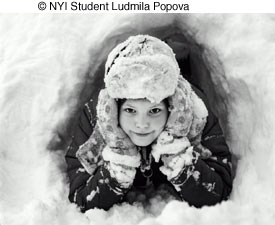
Let your camera warm up slowly. Place it on a cool windowsill or an unheated porch for a couple of hours so it can rise slowly to room temperature. Condensation can play havoc with an all-electronic camera. This is where the suggestion of wrapping a cold camera in a plastic bag comes into play. The moisture will settle on the outside of the bag rather than on the camera's outside and inside surfaces. You can protect the delicate electronics this way. In fact, it's best if you place the bag on the camera while still outside, not when you bring the camera in.
With these simple precautions and camera tips, you'll be able to take great cold weather pictures. Winter offers exceptional opportunities for wonderful landscapes because of its crystal-clear air. So don't be daunted when the temperature drops into the Arctic zone. Just dress properly, take these few winter photo tips to heart, head outdoors, and get going!
For more information on winter photography, and digital photography tips, you may also want to read NYIP's articles Snow Business: A Digital Perspective and How to Take Great Skiing and Snowboarding Pictures.






